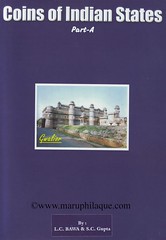
About UsThe Numismatic Bibliomania Society is a non-profit organization promoting numismatic literature. For more information please see our web site at coinbooks.org SubscriptionsThose wishing to become new E-Sylum subscribers (or wishing to Unsubscribe) can go to the following web page link MembershipThere is a membership application available on the web site Membership Application To join, print the application and return it with your check to the address printed on the application. Membership is only $15 to addresses in the U.S., $20 for First Class mail, and $25 elsewhere. For those without web access, write to: David M. Sundman, Secretary/TreasurerNumismatic Bibliomania
Society AsylumFor Asylum mailing address changes and other membership questions, contact David at this email address: dsundman@LittletonCoin.com SubmissionsTo submit items for publication in The E-Sylum, just Reply to this message, or write to the Editor at this address: whomren@coinlibrary.com
BUY THE BOOK BEFORE THE COINYou won't regret it! |
- WAYNE'S WORDS: THE E-SYLUM MAY 8, 2011
- CZAHOR MAIL BID SALE XV CLOSES JUNE 14, 2011
- BOOK REVIEW: PRECIOUS METALS: INVESTING & COLLECTING IN TODAY'S SILVER, GOLD AND PLATINUM MARKETS
- EXHIBIT: MYTH AND COINAGE
- MORE ON DANIEL K. E. CHING AND ARTHUR COOLE
- WHAT IS IT? BOOK? PERIODICAL? OR WHAT?
- COLONIAL CURRENCY PRINTING PLATE SPARKS WAR BETWEEN STATES
- QUERY: INFORMATION ON CLIFFORD HEWITT (1869-1942) SOUGHT
- QUERY: CATALOGS SOUGHT FOR FLYING EAGLE CENT PATTERN RESEARCH
- NOTES FROM E-SYLUM READERS: MAY 8, 2011
- NATIONAL POSTAL MUSEUM ACQUIRED CONFEDERATE STAMP PRINTING PLATE
- 2011 ROYAL AND BRITISH NUMISMATIC SOCIETIES SUMMER MEETING
- INDIA RECALLS ALL SMALL DENOMINATION COINS
- RARE ALBERT MEDAL WAS AWARDED TO ABORIGINAL AUSTRALIAN PRISONER
- BONHAM'S TO SELL RARE EARLY FOOTBALL MEDAL
- HEALTH TIP: DON'T SWALLOW POLYMER BANKNOTES
- FEATURED WEB PAGE: THE 1715 FLEET SOCIETY PHOTO GALLERY
WAYNE'S WORDS: THE E-SYLUM MAY 8, 2011

Among our new subscribers this week is Rick Irons. Welcome aboard! We now have 1,423 email subscribers, plus 139 followers on Facebook, including Memo Marin and Mile Kocev.
This week we open with a note about Rsy Czahor's literature sale and a review of a new book on Precious Metals. Other topics include stamp and currency printing plates, Arthur Coole, what happens when you swallow a polymer banknote. Have a great week, everyone!
Wayne Homren
Numismatic Bibliomania Society
CZAHOR MAIL BID SALE XV CLOSES JUNE 14, 2011
Eric von Klinger writes:
I got a mailing from Ray Czahor (Cookie Jar Collectibles) for his Mail Bid Sale XV. It's all books -- 433 lots -- and many are obscure but intriguing. Ray is a specialist in the Philippines, but these books cover a variety of fields. The minimum bids are generally quite low. Clain-Stefanelli's 1968, 108-page "History of the National Numismatic Collections," e.g., has a M.B. of $2.50. Ray still has his last sale, not this one, on his Web site. This sale doesn't close till Flag Day, June 14. You can e-mail cookiejarpi@verizon.net. The address is Box 597, Columbia MD 21045.
BOOK REVIEW: PRECIOUS METALS: INVESTING & COLLECTING IN TODAY'S SILVER, GOLD AND PLATINUM MARKETS
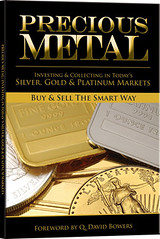 Precious Metals: Investing & Collecting in Today's Silver, Gold and Platinum Markets - Buy & Sell The Smart Way, with a foreword by Q. David Bowers. Reviewed by John and Nancy Wilson, NLG
Precious Metals: Investing & Collecting in Today's Silver, Gold and Platinum Markets - Buy & Sell The Smart Way, with a foreword by Q. David Bowers. Reviewed by John and Nancy Wilson, NLG
Since the late 1960's when silver coins were still available and found in change you received at a store, bank rolled coins with silver in the coins, have always been of interest to us. We have watched over the years the prices of not only silver but gold and platinum go up and down for many reasons. In the past months the price of gold and silver has gone up tremendously. Now, in the past week it has once again gone down. What goes down probably will go up in time? In any case the prices of precious metals are always talked about by the media across the world.
The precious metal commodity is hyped tremendously by companies selling them on television, radio and newspapers. People always ask us if these ads selling these silver, gold or platinum coins are good buys. If you invest in anything that is offered via the media (outside the coin hobby) you probably will be ripped off. We have always thought precious metals were a safe place to put some of your money. The reason being that if at some time we have a serious depression or other disaster. Precious metals in coin form have always had value from the time of Lydia in the seventh century B.C. They used electrum, a mixture of gold and silver found in nature, to mint coins. From the seventh century B.C. to the coins or metals made today of precious metals they have value. Do we have all the answers on buying or selling coins absolutely not.
This "Precious Metals" book will give you sound advice on investing and collecting in this market place. It gives a brief history of gold and silver and why they are valuable. Platinum and other precious metals are also discussed. There are beautiful full color pictures of many of the current and historic gold and silver coins as well as charts showing the historic prices for gold, platinum and palladium.
To aid you in selling your gold, the book gives many important points on gold such as the fact that gold is measured in troy ounces with only 12 ounces to the pound as well as weight conversion tables for gold from 9 to 24 karats and the value of the gold at different prices per ounce for bars verses various coins.
The objective of the book is to make the dealer, collector or investor a knowledgeable seller and buyer of gold and other precious metals in these days of skyrocketing or plunging prices. A section deals with the recognizing and avoidance of counterfeit and altered coins. We recently attended a Central States Numismatic Society educational program in Rosemont, IL. It was fascinating to hear that even silver bars were being counterfeited and sold.
Precious Metals: Investing and Collecting in Today's Silver, Gold and Platinum Markets is a full color soft cover 144 page reference with all the answers. It retails for $9.95 from Whitman Publishing or your favorite book dealer. We think it would be a wothwhile book for dealers, collectors and investors. If it was in every library, many people after they read it, would be able to make sound decisions on whether to buy (or even sell) precious metals. Buy & Sell The Smart Way is on the cover of the book and it would be a smart thing for you to buy this important reference. For information on this book you can contact, Whitman Publishing, LLC, 3103 Clairmont Road, Suite B, Atlanta, GA 30329, or call (800) 546-2995 or visit their web page at, www.whitmanbooks.com
EXHIBIT: MYTH AND COINAGE
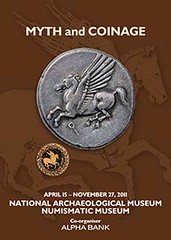 For the first time, the National Archaeological Museum, the Numismatic Museum and the Alpha Bank Numismatic Collection collaborate and co-organise the temporary exhibition entitled "Myth and Coinage", which will be presented concurrently in both Museums from April 15 to November 27, 2011.
The exhibition offers the possibility of a dialogue between Greek Mythology and ancient coinage and focuses on the illustration and use of myth on the faces of coins since the 7th century BC onwards.
For the first time, the National Archaeological Museum, the Numismatic Museum and the Alpha Bank Numismatic Collection collaborate and co-organise the temporary exhibition entitled "Myth and Coinage", which will be presented concurrently in both Museums from April 15 to November 27, 2011.
The exhibition offers the possibility of a dialogue between Greek Mythology and ancient coinage and focuses on the illustration and use of myth on the faces of coins since the 7th century BC onwards.
In the exhibition unveiled at the National Archaeological Museum 261 coins from the Alpha Bank Numismatic Collection – which numbers more than 10,000 items and is considered one of the richest and most significant in the world – are showcased for the first time, alongside 71 coins from the Numismatic Museum and 79 selected artefacts from the National Archaeological Museum collections: sculptures, vases and metalwork. The exhibition has been divided in five sections with the purpose of promoting and highlighting the mythological themes depicted on the faces of coins throughout antiquity.
The first section, "The Dodecatheon", is dedicated to the Olympian deities. The heads of the gods and goddesses as well as their attributes (e.g. owl, thunderbolt, etc.) adorn the obverse or the reverse of coins issued by ancient cities and kingdoms. The colossal marble head of Zeus from Aigeira in Achaia or the bronze statuette of the father of the gods brandishing the thunderbolt are exhibited beside bronze coins of Elis or Messene that bear the same iconographic theme.
The second section, "Mythical creatures", includes representations of creatures like the Griffin, the Sphinx, the Chimaera or Medusa, which were significant emblems for the issuing authority. These daemons, which stood in-between gods and humans, were thought of as "guardians of mortals" and as such were depicted on coins often replacing the deity itself. Hence, a bronze figure of a Centaur is on display next to a coin of Demetrias in Magnesia (Centaurs resided on Mt Pelion).
The third section, "The demigod Heracles", is dedicated to the greatest hero of Greek Mythology. Heracles and his labours adorn the issues of many cities. For example, Heracles and the Nemean lion are depicted on a black-figure krater and a silver coin of Nemea.
The fourth section, "The secondary deities", includes those figures not as powerful as the Olympian gods but who nonetheless had a significant role in the lives of humans, like Asclepius (in Epidaurus) or Helios (in Rhodes).
The final fifth section, "Heroes and mythical stories", includes depictions of heroes and mythical stories, primarily from the Iliad but also from mythological sagas, associated with local coinages. Opting to depict Homeric or local heroes served the need of the rulers to promote themselves and to attain a heroic ancestry or the moral dimensions of their selected hero (e.g. Pyrrhus, king of Epirus).
135 coins, 22 medals and 15 banknotes from the Numismatic Museum collections will be on display. Moreover, on temporary loan, 15 ancient Greek coins from the Alpha Bank Numismatic Collection, 13 artefacts from the National Archaeological Museum collections, 2 paintings from the National Gallery and one painting from the Bank of Greece collection will also be presented.
To read the complete article, see: Myth and Coinage (www.coinsweekly.com/en/News/4?&id=573)
HOW MANY OF THE 100 GREATEST MODERN COINS
DO YOU OWN?
MORE ON DANIEL K. E. CHING AND ARTHUR COOLE
The item in the last E-Sylum about Daniel K.E. Ching and Rev. Arthur B. Coole by Bruce W. Smith brought back a lot of good old memories about those two men!
I started collecting Vietnamese cash coins in 1964 along with other Southeast Asia financial instruments. There were not many collectors, and even fewer researchers, in 1964, I could correspond with about my new addiction. And I had no time when I started six years of service in the Vietnam war and also being in other overseas assignments. But when I returned to the USA in 1973 for three years, I started some serious correspondence with anyone I could discover who had even the slightest interest in my collecting and research areas.
One of those people I contacted was the Rev. Arthur B. Coole. He was becoming quite fragile when we first started corresponding and I could easily tell by his wiggly writing. Within a couple of years he passed away. But in those few years, he got my head straight in many areas, and I acquired all of his books for my library.
Then I found Daniel K.E. Ching. Daniel and I probably corresponded for fifteen years and traded pieces back and forth about quarterly. When I got discouraged in a particular area, he would "kick my butt" in a letter and get me started again. He was a great help to me over many years. When my wife discovered he was a single man, she started scheming to set him up with one of our nieces in Viet Nam. He declined many times but Phung never gave up. We was very sad to learn of his passing. We had never met Daniel but he was like a brother to us.
Bruce was also one of those "early" correspondents with me and he has also been a big help to me, even as recently as last year when I visited him and his wife in Sheboygan, WI. He allowed me to dig through his folders and scan what I could find of interest about Southeast Asia. We thought I might find a dozen pages or so but I scanned over fifty.
There are many other "old" guys I could mention like Dr. Alan Barker and Mr. Hung who I can write about in the future, but the small "crowd" of us is thinning down in the West. And the great number of fakes coming onto the market is driving some "young" people who start to be interested in them away to other areas. The one good thing I see are more collectors and researchers in Viet Nam, but they are mostly working alone and not sharing their knowledge. Part of the reason is the distance between them and that they do not know each other. There is no national numismatic organization in Viet Nam at this time because the government has not yet authorized it. Once it is authorized, I am hoping it will bring everyone in Viet Nam and elsewhere together to create a new "crowd" of researchers working with each other.

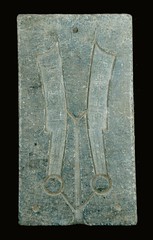
MC-2 Part of a clay mold for a spade coin from the Wang Mang period (AD 9-23). The mold was formerly in the collection of the famous Ch'ing dynasty collector, Li Tso-hsien, who published it in 1875.
MS-7 A mold for a Ch'i state knife coin, from around 500-300 BC).
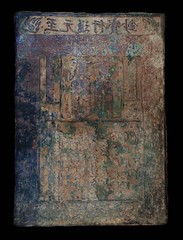

P2 Bronze printing plate for a Yuan Dynasty 2 String note of the Chih Yuan period (1264-1294), one of eight excavated at a former mint sight in north China during the Japanese occupation (1930's). This is the only one I know of which is privately owned; the 8 or 10 others known to exist are in museums in China, the USA and Europe. This plate was used a hundred years before the well known Ming note.
PP8 Ch'ing Dynasty printing plate from the Yung Te Hsin Chi Bank in Peking, denominated in silver taels, dated to 1870-1912.
To read the earlier E-Sylum article, see: COOLE CHINESE COINS TO BE OFFERED (www.coinbooks.org/esylum_v14n18a07.html)
WHAT IS IT? BOOK? PERIODICAL? OR WHAT?
Howard A. Daniel III writes:
 I have two six-page publications from the United Nations dated 2006 and 2007. These publications describe a series of United Nations stamps issued with the flag and coin of each nation in that body. The cover has the United Nations seal and another seal with Coin and Flag Series in three languages, and these languages are repeated below the seal. The back page has it identified as being printed by the United Nations Postal Administration, some other information and that it was Printed on Recycled Paper. All of the pages are very stiff card-like paper so the it is likely only about 10-20% recycled, but they got their politically correct line on it.
I have two six-page publications from the United Nations dated 2006 and 2007. These publications describe a series of United Nations stamps issued with the flag and coin of each nation in that body. The cover has the United Nations seal and another seal with Coin and Flag Series in three languages, and these languages are repeated below the seal. The back page has it identified as being printed by the United Nations Postal Administration, some other information and that it was Printed on Recycled Paper. All of the pages are very stiff card-like paper so the it is likely only about 10-20% recycled, but they got their politically correct line on it.
There are four other pages. The first three have two each souvenir sheets of four stamps with different countries' flags and coins on them, and the final page has information in three languages about when the publication was issued, who designed it, who printed it, etc. The two publications show three of my four countries; Viet Nam, Myanmar and Cambodia, so I am still looking for the one with the Lao stamp.
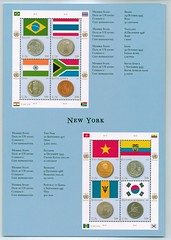 I have a question for our fellow bibliomaniacs. What is this publication called? Is it a pamphlet? Is it a booklet? Is is it a whatever? When I list references in the Bibliography sections of my catalogs, I separate them into Books, Periodicals, Flyers, Booklets, etc. Under what reference should I list these publications?
I have a question for our fellow bibliomaniacs. What is this publication called? Is it a pamphlet? Is it a booklet? Is is it a whatever? When I list references in the Bibliography sections of my catalogs, I separate them into Books, Periodicals, Flyers, Booklets, etc. Under what reference should I list these publications?
As for how to list such items in a bibliography, I'm not sure if there is a standard. Perhaps our readers can fill us in. Generally the would be listed much as a book would, under the name of the author or publisher, if known. For instance, here's an entry from The Secret History if the First U.S. Mint by Orosz and Augsburger: "Stewart, Frank H," Inspection of the First Coins of the United States Mint", Printed brochure attached to the back of Frank H. Steward Electric Compny calendars." -Editor
THE BOOK BAZARRE
COLONIAL CURRENCY PRINTING PLATE SPARKS WAR BETWEEN STATES
A Minnesota coin collector has discovered just how seriously New Hampshire takes its motto of Live Free or Die in a brouhaha over a Colonial-era antique that has sparked its own revolutionary war of sorts. Gary Lea stumbled across a money-printing plate that some experts say could trace to the days of Paul Revere and could be worth six figures, according the La Crosse (Wis.) Tribune.
But the profit isn't coming, the profit isn't coming for Lea because the state of New Hampshire contends that there's no such thing as a free antique and it's dying to get its relic back. The state claims it is the rightful owner, even though the coin collector happened upon the copper printing plate during an estate sale in the Gopher State, the Tribune reports. The artifact traveled through several states before Lea found the treasure. Lea sleuthed the background of the memento, which carried a date stamp of 177-, with the final numeral obliterated from age and grit. He discovered that the plate probably had been used to print money used to pay New Hampshire's share of the Revolutionary War, according to the Tribune. After buying the plate for a price Lea won't disclose, he told the Tribune, "I knew I couldn't afford to keep it. I was happy just to have known that I was the owner of it at one time, and part of its rediscovery."
He contracted to sell it at an auction, until the New Hampshire Attorney General's Office intervened and said the state wants its heirloom back. Lea canceled the sale, even though the auction house said it was obvious that he had clear title.
Lea sued New Hampshire in Fillmore County, Minn., a maneuver that the Tribune notes raised legal questions such as whether a person can sue one state in another; whether a state can demand to reclaim items it contends are part of its history and treasury; and which state might have jurisdiction over a plate that was crafted in New Hampshire and found its way to an estate sale in Minnesota, after stops over the centuries in Maryland and Michigan, at least.
But Fillmore County Judge Robert Benson recently ruled that Minnesota has jurisdiction to decide the rightful owner, and the court has three months to render its final decision, the Tribune reported.
To read the complete article, see: Revolutionary War Antique Discovery Propels War Between States (www.newsmax.com/US/antique-Minnesota-NewHampshire-RevolutionaryWar/2011/05/02/id/394765)
QUERY: INFORMATION ON CLIFFORD HEWITT (1869-1942) SOUGHT
Bruce W. Smith writes:
I am looking for information on Clifford Hewitt (1869-1942). He was a technical expert and perhaps an engraver at the U.S. Mint -- he set up the Manila Mint in the Philippines. Later he became technical expert at the Shanghai Mint in China. I would like to know his exact name. Some say it was really Clifford R. Hewitt, others say R. Clifford Hewitt. He left the Shanghai Mint in 1933 -- what did he do afterwards?
QUERY: CATALOGS SOUGHT FOR FLYING EAGLE CENT PATTERN RESEARCH
R.V. Dewey writes:
Would anyone have a copy of Steigerwalt #62 (May 21-22 1907) and/or Bangs and Merwin, June 17th 1870? Both catalogs I am looking for reference "sets" of Roman numeral 1855 Flying Eagle Cents. One or two sets were for presentation but one set of Roman numeral 1855 Flyers was kept in the Mint. "Six specimens, said to illustrate the various alloys, from copper to nearly pure nickel, in which they were struck. These are supposed to be from the Mint where used as samples. Five have very light marks." Note: how is one supposed to find "very light marks" when it's "small" and "scratched into" according to Taxay, an extremely hard metal surface like nickel?
Interestingly enough on June 17th 1870 there were no less than three numismatic auctions that day. One auction had approximately 167 Lots. The next had approximately 226 Lots. The third auction with approximately 600+ Lots is Steigerwalt #62, where an "entire" set of eight 1855 Roman Numeral Flyers is touted by the Bangs and Merwin's auctioneer in 1870, "as sets very rare; 8 pieces." Note: only 15 years after minting these sets, they were considered very rare.
Witch Eye™ is a Judd 171A, NCS Proof 1855 Flyer Roman Numeral IIII. Most likely from the "Mint samples." I remarked earlier that the coin appeared to have been hit with a rainbow due to the colors on the obverse and reverse that can only be seen in certain light. The black spots come to life and turn bright red and green hues on the obverse and reverse surface of the nickel pattern. Roman numeral IIII 1855 Flyer is quite likely and even probably the previously mentioned Mint sample.
On the other hand the Farouk Flyer™ is a Judd 171, 1855 Flyer Roman numeral I and I believe because of the exquisite condition of this PCGS Proof 63 and the Farouk provenance, this pattern was likely a presentation piece. The last time a Roman numeral 1855 Flyer set was offered at auction was over 100 years ago (1907) unless someone knows of a more recent offering. Thank you for your help. Lastly, does anyone have or know of a picture anywhere of the great Anthony C. Paquet?
THE BOOK BAZARRE
NOTES FROM E-SYLUM READERS: MAY 8, 2011
Did anyone have any success in contacting the seller of that book on Indian coins? I tried but got no reply.
To read the earlier E-Sylum article, see: NEW BOOK: COINS OF INDIAN STATES - PART A (www.coinbooks.org/esylum_v14n17a05.html)
Chris Faulkner writes:
To be a perfect pedant about this, in the article "Numismatic Vocabulary: What's the Differents?" from last week's E-Sylum, the word "different" (or plural "differents") should be spelled différent (or différents), and pronounced accordingly. Différent in French is ordinarily an adjective not a noun, and as an adjective it does translate as "different." However, as a noun to indicate the name of an engraver, such a translation will clearly not do.
To read the earlier E-Sylum article, see: NUMISMATIC VOCABULARY: WHAT'S THE DIFFERENTS? (www.coinbooks.org/esylum_v14n18a09.html)
NATIONAL POSTAL MUSEUM ACQUIRED CONFEDERATE STAMP PRINTING PLATE
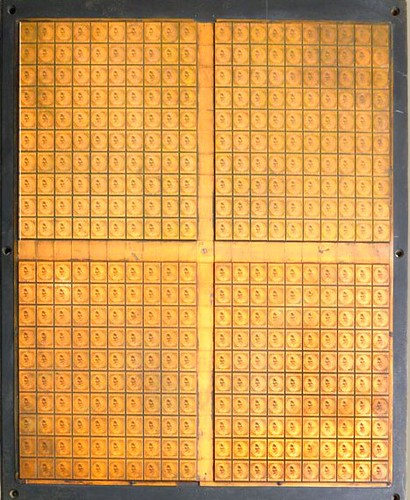
The Smithsonian's National Postal Museum has acquired from The Franklin Institute a Confederate postage-stamp printing plate that was confiscated during the Civil War. The printing plate contains 400 5-cent Jefferson Davis stamp images etched in copper and weighs nearly 100 pounds. The copper plate was ordered by the Confederate States of America and manufactured by De La Rue & Co. of London in 1861. The federal vessel Mercedita captured the British ship Bermuda between Bermuda and Nassau April 27, 1862, and as part of the contraband, the printing plate was brought to Philadelphia and sold. It was never used to print stamps by the Confederacy.
The Confederate printing plate was acquired by The Franklin Institute in 1954, when it was actively building a philatelic collection. Subsequently, the institute has deacessioned and disposed of most of its postal-related objects, finding that philately is no longer consistent with its educational mission.
"This spectacular acquisition will be a centerpiece in the display case of the three-dimensional objects from the National Philatelic Collection to be featured in the new William H. Gross Stamp Gallery,"said Cheryl R. Ganz, chief curator of philately. "The 5-cent plate provides a wonderful connection to the first philatelic object ever collected by the Smithsonian Institution-a pane of the Confederate States of America's 10-cent blue Jefferson Davis stamp."
"It is appropriate that the Smithsonian's National Postal Museum was able to acquire the historic captured Confederate printing plate at the beginning of the commemoration of the Civil War Sesquicentennial," said Trish Kaufmann, president of the Confederate Stamp Alliance. "Its significance to American postal history cannot be overstated."
To read the complete article, see: National Postal Museum Acquires Rare Confederate Printing Plate from the Franklin Institute (www.artdaily.org/index.asp?int_sec=2&int_new=47161)
KOLBE & FANNING JUNE 2, 2011 SALE HIGHLIGHTS
Rare and Unusual Publications on American Numismatics IncludingEckfeldt & Du Bois's delightful 1850 work featuring actual samples
of California Gold Rush nuggets;
the famous 1929 Elder sale catalogue of the Lawrence Collection,
including a full set of 22 original photographs depicting Lawrence's pioneer gold,
ancient coins, English and European rarities, and American colonial coins
Catalogue Available at Our Web Site: www.numislit.com
Printed Catalogues $10.00
KOLBE & FANNING NUMISMATIC BOOKSELLERS
141 W JOHNSTOWN ROAD, GAHANNA OH 43230-2700
(614) 414-0855 • df@numislit.com • GFK@numislit.com
2011 ROYAL AND BRITISH NUMISMATIC SOCIETIES SUMMER MEETING


RNS/BNS 2011 SUMMER MEETING — THE VALUE OF MONEY
The Royal and British Numismatic Societies will hold their 2011 joint summer meeting on Saturday 2 July, at the National Museum Wales in Cardiff.
As in past years, the annual joint Summer Meeting is a chance for numismatists to meet and discuss the day's topic in relaxed and convivial surroundings. Members and non-members alike are invited to join us for a thought-provoking day of lectures on the topic ‘The Value of Money'.
A number of speakers will approach the theme from a variety of different angles, across several historical periods. These include:
Matthew Bonaccorsi, Head of Design at the Royal Mint, will examine the relationship between coin design and our understanding of a coin's value, along with the evolution of this in a world that relies increasingly on digital methods of payment.
Amelia Dowler, Curator of Greek Coins at the British Museum, ‘The Cost of Living' drawing on the forthcoming British Museum exhibition, this will challenge our perceptions with a comparison between the cost of living in Roman times and in modern Britain.
Dr Robin Eaglen, President of the British Numismatic Society, will offer some thoughts on the coin market.
Dr Anne Murphy, Lecturer in History at the University of Hertfordshire, will investigate how the Bank of England protected its status as the ‘guardian of public credit' in the later eighteenth century.
Professor Peter Spufford, Professor Emeritus of European History at Queen's College, Cambridge, will examine examples of coinage debasement in Medieval Europe.
Full details of the event programme, information on the venue and how to book your place are available on the RNS website, www.numismatics.org.uk.
The registration fee for the day is £30.00, which includes coffee on arrival, lunch, and afternoon tea. Registration opens at 10.00 and the meeting will commence at 10.30. Attendees can register and pay online at the RNS website, www.numismatics.org.uk, or send a cheque made payable to the Royal Numismatic Society to:
RNS/BNS Summer Meeting
Royal Numismatic Society
℅ Department of Coins and Medals
The British Museum
Great Russell Street
London WC1B 3DG
For further information please contact Jenni Adam on 020 7601 5793, or by email at jennifer.adam@bankofengland.co.uk
INDIA RECALLS ALL SMALL DENOMINATION COINS
Deadline: June 30, 2011. All coins of 25-paise and lower denomination are being recalled throughout India. The 50-paise will remain the lowest coin in circulation. Bring all such coins less than 50-paise to the nearest bank, but not after June 30th!
The economy is the reason for the massive recall. It is just not effective for low-value coins to circulate. Sound familiar? This is occurring all over the world. Transactions are being rounded off to the lowest coin in circulation.
But this is the first such notice of such recalls that I have seen which mentions some coins should be retained for numismatic purposes.
"Some parents said that they would retain some [coins] as keepsake," stated the news story "to show the future generation how the coins looked like in the past." Also: "A few years hence, they may fetch good numismatic value, feel a few."
To read the article, see: Bangalore: Come June 29, a Quarter won't be Worth a Penny! (mangalorean.com/news.php?newstype=broadcast&broadcastid=236775)
RARE ALBERT MEDAL WAS AWARDED TO ABORIGINAL AUSTRALIAN PRISONER
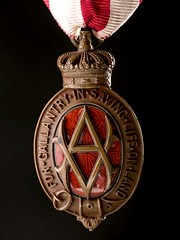 A medal given to an Aboriginal prisoner who saved the life of a policeman nearly 100 years ago will go on public display in the Northern Territory Library today.
A medal given to an Aboriginal prisoner who saved the life of a policeman nearly 100 years ago will go on public display in the Northern Territory Library today.
The man, known as Neighbour, was awarded the Albert Medal by King George V after saving the life of Mounted Police Constable William Johns during a river crossing in the Northern Territory in 1912.
He was the first Indigenous Australian awarded a medal for gallantry.
Indigenous Development Minister Malarndirri McCarthy says Neighbour's actions were heroic.
"The extraordinary thing about the awarding of this is that Neighbour was a prisoner for the police officer at the time and he had chains around his neck," she said.
Neighbour was being escorted by Constable Johns to face trial in Darwin for raiding a fencer's hut.
The policeman slipped off his horse in a flooded river and was kicked in the face by the horse as it was swept away.
Constable Johns clung desperately to pandanus palm fronds on the river edge.
Neighbour, still wearing a neck chain, dived in and saved his life.
Ms McCarthy says he was later honoured for his extraordinary courage.
The Albert Medal was introduced in 1866 and was named after Queen Victoria's consort, Prince Albert, who died in 1861.
"Only 27 Australians received the medal before it was discontinued and replaced by the George Cross," Ms McCarthy said.
To read the complete article, see: Albert Medal returned to NT (news.ninemsn.com.au/national/8245655/albert-medal-returned-to-nt)
BONHAM'S TO SELL RARE EARLY FOOTBALL MEDAL
 A star shaped medal awarded to the Sheffield Wednesday footballer and politician, W. E. Clegg (1852-1932), is to be sold at Bonhams, Chester, as part of its Sporting Memorabilia sale on 1 June 2011. The medal, which was discovered in a box of assorted items brought into the Bonhams' Exeter office by an unassuming client, has attracted a pre-sale estimate of £1,500 – 2,000.
A star shaped medal awarded to the Sheffield Wednesday footballer and politician, W. E. Clegg (1852-1932), is to be sold at Bonhams, Chester, as part of its Sporting Memorabilia sale on 1 June 2011. The medal, which was discovered in a box of assorted items brought into the Bonhams' Exeter office by an unassuming client, has attracted a pre-sale estimate of £1,500 – 2,000.
W. E. Clegg played a significant role in the formation of football. Along with his brother, Charles Clegg, he was also the first Sheffield Wednesday player to earn international caps for England. After retiring from football through injury he was elected the Lord Mayor of Sheffield (1898) and was often referred to as the ‘uncrowned King of Sheffield'.
Clegg was awarded this medal for winning the Sheffield Association Cup on 12 May 1877, when Sheffield Wednesday defeated Heeley 4-3 at Bramhall Lane in front of 6,000 fans. It was the first ever trophy won by Sheffield Wednesday.
To read the complete article, see: Medal Awarded to Sheffield Wendesday's W. E. Clegg to Sell at Bonhams (www.artdaily.org/index.asp?int_sec=2&int_new=47113)
HEALTH TIP: DON'T SWALLOW POLYMER BANKNOTES
A Vietnamese man paid the price when he swallowed a polymer bank note which punctured his stomach, media reports said Friday.
The 29-year-old was in stable condition after surgery on Thursday at a hospital in south central Khanh Hoa province, according to the website of Tuoi Tre newspaper.
The patient had suffered from severe intestinal pain for a week after ingesting the 100,000 dong ($4.50) note for unexplained reasons, the report said.
To read the complete article, see: Vietnamese man pays price of swallowing money (news.ninemsn.com.au/article.aspx?id=8246006)
FEATURED WEB PAGE: THE 1715 FLEET SOCIETY PHOTO GALLERY
This week's Featured Web Page is suggested by Ray Williams, who writes: " This is a pretty cool website." Thanks!Our photo gallery depicts some of the highest quality images of treasures recovered from Spanish galleons lost in Florida waters. These photos were taken by Dr. John de Bry, who is director of the non-profit Center for Historical Archaeology in Melbourne, Florida. Dr. de Bry has extensive experience in photographing artifacts recovered from Spanish shipwrecks.
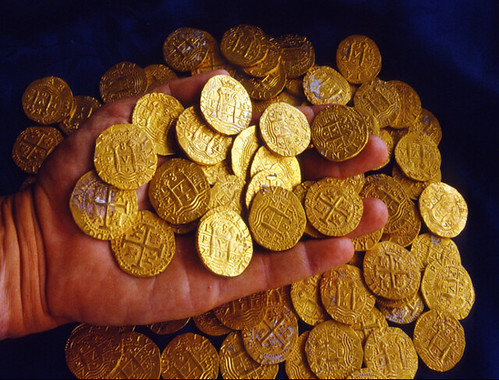
www.1715fleetsociety.com/html/photo_gallery1.html

